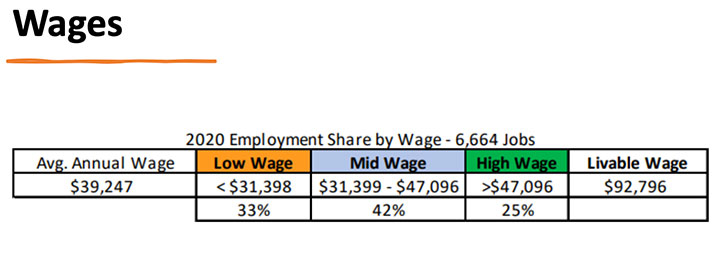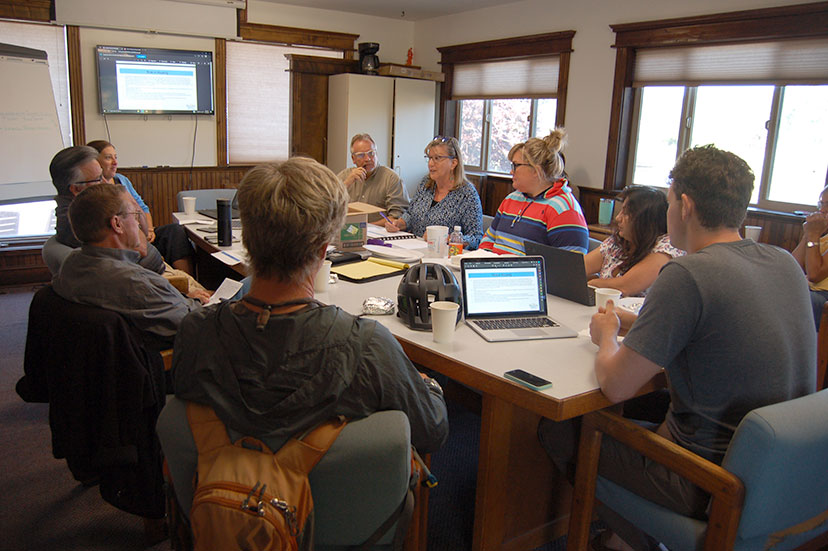PHOTO: A meeting of the Pagosa Springs Area Tourism Board, July 2021.
I began yesterday’s installment with this short quote from the 2019 ‘Destination Master Plan’ for Archuleta County, written by Wisconsin-based Place Dynamics:
Compared to its peers in Colorado and across the nation, Pagosa Springs has a very sophisticated tourism promotion infrastructure…
Based on my research for the Daily Post, over the past decade or so, I would have to agree with that assessment. As one of the best-funded government departments in Archuleta County, the Pagosa Springs Area Tourism Board has, with the help of its professional staff, spent over $11 million in tax revenues, since 2007, developing a “very sophisticated tourism promotion infrastructure”.
During that same period, Pagosa Springs has gradually become unaffordable to the average working individual or family. The 2022 ‘Livable Wage’ report by Region 9 Economic Development District pegged Archuleta County as the “most expensive place to live” in Southwest Colorado.
Back in March, Region 9’s Project Manager Heather Otter gave the Town Council a presentation on our various economic sectors. It’s typical for organizations like Region 9 to define “The Tourism Sector” as the most important sector in our local economy, but maybe without giving us any clear indication of how “The Tourism Sector” is being defined.
For example:
Is a restaurant part of “The Tourism Sector”? I was at the Pagosa Baking Company during spring break, earlier this year, and nearly everyone in the place was wearing ski pants. But the following Monday, I recognized most of the customers at Pagosa Baking as local residents. I would be willing to bet that Pagosa Baking survives mainly on local customers for most of the year.
Tourist support of our restaurants is a seasonal occurrence; most of our restaurants would dry up and blow away without local customers. Region 9 is very aware of this dynamic, and Ms. Otter mentioned it during her presentation, but she didn’t provide a definition of what “A Tourism Economy” truly is.
Her presentation touched on the stressful situation facing our local working families:
“The average annual wage, across [Archuleta County], is around $39,000… I know many of you are aware that Archuleta County got the award for being the most expensive place to live in Southwest Colorado, in the last ‘livable wage’ update that we did. You finally surpassed La Plata County…”
She gave a slightly uncomfortable laugh.
“I want to differentiate between ‘minimum wage’ and ‘livable wage’. Minimum wage is a wage that has to be paid…”
Here in Colorado, the minimum wage is $13.65, and $10.62 for tipped employees. With the passage of Amendment 70 in 2016, Colorado’s minimum wage was increased to $9.30 per hour and was increased annually by $0.90 each January until it reached $12 per hour effective January 2020. Thereafter it is adjusted annually for cost of living increases, as measured by the Consumer Price Index used for Colorado.
“A livable wage is not a minimum wage. A livable wage means, what is the wage that would cover the basic necessities to keep an individual or a family paying their bills without getting any subsidy. This is not ‘putting away a lot of savings and going on vacation’. This is what it takes to live…
“So for a single adult, to live here, just meeting their needs, would need to make about $39,700 a year. When you add children to the mix, it jumps substantially… For a family of four, they would need $92,000…”
Actually, closer to $93,000.

Ms. Otter says the average wage in Archuleta County is $39,000 a year. That suggests that about half of our workers are earning less that $39,000 a year.
If we assume that many, and maybe most, of the workers earning less than $39,000 a year are younger individuals rather than mature, seasoned professionals — which seems like a sensible assumption — we can then guess that half of our workforce — mostly younger workers — cannot actually afford to live here, unless they can find a ‘group living’ situation where the rent is shared.
Some landlords do not approve of ‘group living situations’. That’s a problem.
On average, two adults with two children might be bringing in two $39,000 salaries. That totals $78,000 a year. But they need $93,000 just to ‘get by’ in Archuleta County.
Either wages are too low… or rents (and utilities and health insurance and car payments and everything else that goes into ‘just meeting their needs’) are too high.
We know the wages are too low. The Root Policy study created for the Town government last November made that very clear. About three decades ago, our local business and government leaders hitched Pagosa’s wagon to a “Tourist Economy”, not fully understanding that a “Tourist Economy” typically pays lousy wages.
The wages are too low. And the rents are too high.
We have both problems going on.
And the $11 million spent by the Pagosa Springs Area Tourism Board on a “very sophisticated tourism promotion infrastructure” has actually made the housing crisis worse.
Providing millions of dollars in tax subsidies to an industry that can’t (or won’t) pay a living wage…
… and that encourages the conversion of homes into Short-Term Rentals…
…is simply a bad idea, in my humble opinion.
Some representatives of the tourism industry do not agree with me, however.
As I mentioned yesterday in Part Two, the Pagosa Springs Town Council met on Tuesday, September 5, and discussed a number of crucial community issues. Also, they discussed a proposal from the Tourism Board to establish a special bank account — a ‘trust account’ — to allow the Tourism Board to begin squirreling away tax revenues for a future “Event Center” as recommended in the 2019 Destination Master Plan. $500,000 would be stashed in the new account this year, if the Council approved the resolution.
The Council did indeed approve the new trust account, on a 4-3 vote.
But not before expressing some concerns about the proposal.
Read Part Four, tomorrow…

